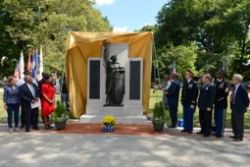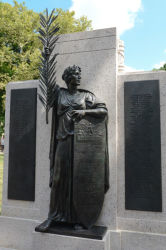Saratoga Park
The Daily Plant : Tuesday, September 30, 2014
"Then They Get Off At Saratoga For The Fourteenth Time"... Historic War Memorial In Bedford Stuyvesant At Last Restored

Photo by Daniel Avila
On April 20, 2000, I received a disturbing phone call from the Brooklyn Parks Deputy Chief of Operations Gregory Dawson. He was calling to report that Brooklyn Park WEP workers had that morning observed that the historic Saratoga Park War Memorial sculpture in Bedford Stuyvesant had been stolen. This brazen crime launched a 14-year saga to recover and restore this community landmark.
The story begins even earlier in 1920, when a Citizen's Memorial Committee of Districts 31 and 32 in Brooklyn raised $5,500 from local residents to commission a memorial to the neighborhood's heroic dead--105 men and one woman (Lillian Patterson who died while working at a local recruiting station) who sacrificed their lives overseas in World War I. The park they chose to locate this memorial was named Saratoga Square after an adjacent street (Saratoga Avenue, itself named after the update town).
The largest park in the immediate area, the square was acquired by the City of Brooklyn for park purposes in 1895, and initially served as an ad hoc circus and recreational grounds before being improved. As it is the largest such amenity in the immediate vicinity, it became well-used by the community.
The Memorial Committee commissioned sculptor James Novelli, an Italian immigrant, who created a bronze relief allegorical female figure holding a palm frond, and supporting a shield—symbols of peace and war. It was cast by Roman Bronze Works, then based in Brooklyn. The relief was installed on a 9’6”-high stele, with two flanking stones, of Milford pink granite, to which were attached bronze honor rolls listing the servicemen who had paid the supreme sacrifice. The monument was dedicated with fanfare in 1921.
Novelli was born in Sulmona, Italy in 1885. His family settled in New York when he was five years old, and he impressed his teachers at PS 23 with his natural artistic skill. He returned to Italy in 1903 to study and graduated from the Royal Academy of Rome in 1908.
Returning to New York, Novelli maintained a studio at West 23rd Street in Manhattan, and was much in demand as a sculptor of funereal and public monuments. Besides this monument he also created the Clason Point War Memorial (1928) in the Bronx, the Winfield War Memorial (1926), Queens, and bronze mausoleum doors in Calvary Cemetery (1923). In the 1930s Novelli worked on the parks monuments crew, and helped to make repairs in 1937 on his Saratoga War Memorial. However, during the Great Depression, his own artistic career languished, and growing increasingly despondent, Novelli tragically took his own life in 1940.
By the 1970s the park system and its monuments had fallen on hard times, and photos from then show the Saratoga Monument damaged and riddle with graffiti. Both honor rolls were stolen on September 24, 1970, followed by the theft of the relief sculpture 30 years later. In the case of the second theft, a swift police investigation helped recover numerous pieces of the sculpture at a local scrap yard. Several suspects were apprehended, but lack of reliable eye-witnesses caused the charges against these defendants to be dropped and the case alas never went to trial (I testified at Grand Jury as an "expert witness" on the value of the piece.)
In 2003 Josephine Murphy, chief librarian of Kingsborough Community College published the book, Novelli: A Forgotten Sculptor. Her research led us to family members of Novelli who had scrapbooks providing much better documentation than we had had previously (images in any public archives were minimal; records from Roman Bronze Works had burned).
Despite much publicity, strong community sentiment, and efforts by our office and Brooklyn Parks to secure monument restoration funds, nearly a decade would pass before appropriations were made. Councilperson Darlene Mealy allocated discretionary funds of $350,000. A specialized capital contract was bid--twice, due to difficulties in procuring submissions--and at long last a contract commenced in 2013. The monument was to be reset in its central park placement, and its bronze elements--honor rolls and relief sculpture--recreated through reference to archival photos and those pieces recovered by NYPD.
The NYC Parks Capital Team included Michele Langlie, preservationist in the Architecture unit, Sakai Brown in Brooklyn Construction, and Arian Lamaj, the resident engineer. On our side of the aisle, Art & Antiquities was vigilant on many project details, most notably the painstaking replication of the missing honor rolls, in which a no longer extant typeface was created, and the correct spelling of all the names corroborated through consultation with veterans records and other source materials. Monuments Program Conservation Managers provided invaluable technical expertise on the bronze casting and fabrication as well as monument construction. The work was executed by WBE Unlimited (the general contractor), Anatoly Mikhailov, figure sculptor, Modern Art Foundry, and Andrews LeFevre Studios.
On September 10 in an elaborate rededication ceremony orchestrated by the irrepressible Brooklyn Parks Chief of Staff Marty Maher, the restored monument was again revealed to the world and returned to the community who had inspired and commissioned it. The NYC Joint Services Color Guard provided appropriate pageantry and gravitas. Attendees included family members of Novelli as well as descendants of several of those servicemen listed on the honor rolls. Speaking were Councilperson Mealy, Brooklyn Borough President Eric Adams, Fort Hamilton Commanding Officer Col. Joseph Davidson, and Libby O'Connell, chief historian for A & E/History Networks, and the local representative of the United States World War I Centennial Commission, who in her remarks commented: "We hope that communities everywhere will follow the lead of Bedford-Stuyvesant.”
--Submitted by Jonathan Kuhn, Director, Art & Antiquities
QUOTATION FOR THE DAY
"One way to get the most out of life is to look upon it as an adventure."
William Feather
(1889-1981)
Check out your park's Vital Signs
Clean & Safe
Green & Resilient
Empowered & Engaged Users
Share your feedback or learn more about how this park is part of a
Vital Park System






